Three Guitars That Changed The World
10mins read • Bryan Clark
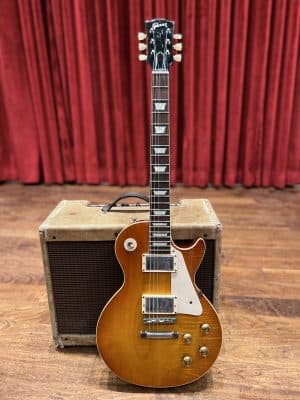
Jump To Section
The Trifecta
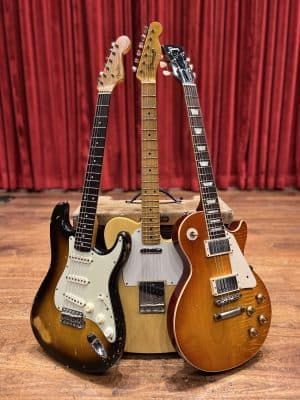
In the world of electric guitar there are three models that are generally regarded as a ‘must own’ at some point. A Les Paul, a Telecaster and a Stratocaster. Since their inception, these three models have quite literally served as the holy trinity of electric guitar aesthetic, influence and design.
Musically speaking, the Big Bang that the Les Paul, Telecaster and Stratocaster caused reordered the existing musical cosmos and created a parallel universe of infinite possibilities for guitar players to explore. Like a Phoenix rising from its acoustic ashes the guitar was reborn – 2.0 and electric – and became the most dominant musical instrument in the world.
For over 70 years, this ecumenical impact has inspired religious-like passion and devotion from guitar players, enthusiasts, collectors and guitar heroes the world over. The influence of these guitars cannot be understated.
The History - Les and Leo
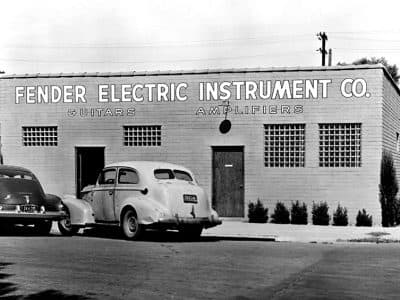
The first four years of the 1950’s were special for electric guitar. In particular for the great culmination of innovative designs coming to market. These originated from Leo Fender’s small radio repair shop in Fullerton, California and the « Wizard of Waukesha » Les Paul, who quietly labored away in the after hours at the Epiphone Guitar factory in lower Manhattan building various prototypes of an electric guitar.
In 1941 Les Paul had developed his « Log guitar » to the point where he traveled to the corporate offices of Gibson, then based in Chicago, and pitched the the idea of making a production line of solid-body electric guitars. After being laughed at, Les went back to New York and continued to develop the idea further before eventually moving to Hollywood in 1944.
In Fullerton, Fender’s shop – Fender Radio Service – had a constant influx of musicians and music lovers. Leo Fender started out fixing lap steels and amplifiers for local musicians who were well known in the Western Swing and Country music scene in southern California. In 1943, he built his first solid body electric guitar with the help of then partner, Clayton ‘Doc’ Kauffman.
By 1949, Leo teamed up with Don Randall and changed the company’s name to Fender Electric Instrument Co. They began making a wide range of finely crafted and popular lap, table and pedal steel guitars as well as amplifiers. That year, he also earnestly began to further develop his solid-body electric guitar.
By 1950, southern California was becoming a de-facto hot bed for the electric guitar. Les Paul, Leo Fender, and Paul Bigsby were freely sharing ideas and discussing innovations during the regular jam sessions at Les Paul’s home in Hollywood.
Bigsby was widely known as a formidable custom luthier who specialized in making unique guitars for each player (Merle Travis’ iconic guitar is a good example). Bigsby also developed a vibrato that could be fashioned to fit onto the top of almost any electric guitar. It was Bigsby’s « Merle Travis » guitar that inpsired Fender to place all six tuning keys on one side of the headstock rather than the traditional three per side.
Leo's Utilitarian Vision
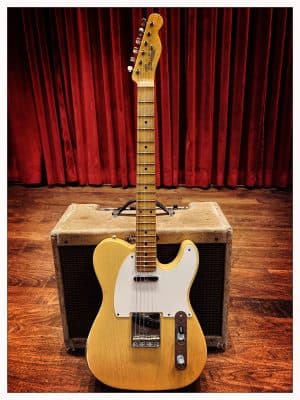

In stark contrast to the premium guitars of Gibson, who carved the tops of their guitars and elegantly glued the neck into the body, Leo Fender used more of a utilitarian, blue collar form-meets-function approach. His newly named « Esquire » guitar featured a novel innovation – a bolt on neck for easy removal and maintenance. To combat intonation problems Fender also designed a string-through body design with micro adjustable saddles seated in a pressed steel bridge plate. He also added height adjustable, single coil pickups that featured separate magnets for each string as well as a master tone and a master volume knob. In short, all designs were tailor made to scale for mass production without sacrificing Fender’s strict high standards and vigilant attention to detail.
The Esquire made its debut in 1950 at the 49th annual National Association of Music Merchants show (NAMM) in Chicago. It featured a single bridge pickup that quickly evolved into a two pickup version with the latter initially named the « Broadcaster ». It was quickly changed to « Telecaster » (both named by Don Randall) due to a law suit filed by Fred Gretsch who already had a drum kit by the same name but with a slightly different spelling «Broadkaster ».
Gibson's Developments - McCarty and Les Paul

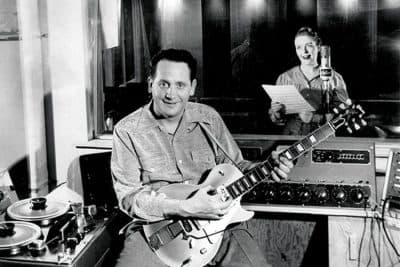
Throughout the 1940’s, Gibson had solidified itself as a premium builder of exquisite, large-body arch-top guitars that could be ordered with or without a pickup. By 1950 Ted McCarty, the newly appointed president of Gibson, had long realized that Fender’s solid-body guitars posed a serious threat to their virtual monopoly of the electric guitar market. He actively pursued Les Paul to partner, collaborate and design a solid-body, carved top electric guitar.
After several experiments, a prototype initiated by McCarty was finally placed in Les Paul’s hands on a now legendary rainy night in Delaware Water Gap, Pennsylvania. Les Paul was impressed, as was Mary Ford, Paul’s singing partner and wife. Later that evening, McCarty, Paul and his financial manager Phil Braunstein drafted a contract and wrote out how much Gibson would pay Les Paul in artist royalties per guitar sold.
It was fortuitous. A year later, Les Paul and Mary Ford would have their first number one record « How High the Moon » (with thirteen other recordings charting in the top ten). The Gibson « Les Paul » model guitar (1952) would be the best selling signature guitar model in history.
Gibson took cues from automotive giants Ford and Chevrolet and produced several models followed in quick succession and broadened Gibson’s price point for guitarists who were interested in buying a Les Paul. The first models were Goldtops (1952), followed by the Les Paul Junior and Les Paul Custom (1954), the Les Paul Special (1955) and finally the Les Paul Standard (1958) which featured fiddle back maple and the legendary ‘burst’ that would eventually phase out the Goldtop that same year.
According to McCarty, both the early Goldtop finish and the all black Custom models were devised to cover up blemishes (mineral streaks, etc) in the wood. Besides the appointments, the all black, Bigsby-laden Les Paul Custom model differed from the Goldtop in that the body was a solid piece of mahogany rather than the standard carved maple top and mahogany back and sides.
Lightning Strikes Again in Fullerton
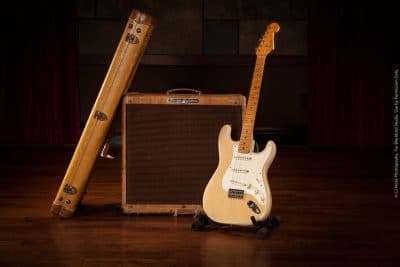
In April 1954, lightning struck again in Fullerton with the debut of the Stratocaster. Preliminary work for a second solid body design began as early as 1951 as Leo focused on improving tone, intonation, player comfort and adding a vibrato (which Les Paul models already featured). Among the list of contributors were Don Randall, Freddie Tavares, Rex Gallion and Bill Carson. Don Randall (Fender’s Head of Sales) continued his model-naming streak and gave the Stratocaster its name, as well as suggested that a third pickup be added for more tonal range. Los Angeles session ace Freddie Tavares (most notably known for his opening lap steel glissando lick that began every Looney Tunes cartoon) would refine the Strat’s body shape by adding the double cut-away, top mounting input jack (the only Fender model to have one) and laying out the two tone, one volume and three-way pickup selector switch. The bevelled front edge and the deep cut contour on the back is attributed to Bill Carson, who had already modified his Telecaster due to discomfort in his right arm and rib cage from the guitar’s hard edges.
The Stratocaster also marked a change in the design of Fender pickups. Unlike the flat pole pieces found in Telecaster models, the Strat would feature staggered pole pieces with varying heights under each string to allow for better tonal balance. That same year, Fender also offered a two-color sunburst for the first time.
Leo designed the Strat’s vibrato unit from the ground up, feeling confident that he could greatly improve on Bigsby’s design. Fender’s « tremolo » was notably different in that it combined a bridge with six individual saddles (one for each string that allowed for accurate intonation) and was coupled with a vibrato that rocked forward as a single unit with the spring tensioning mechanism routed directly into the back of the body of the guitar.
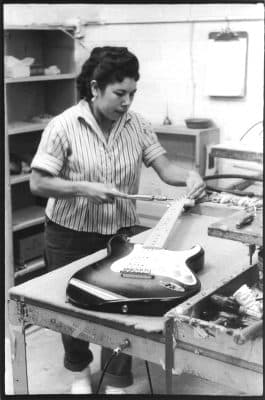
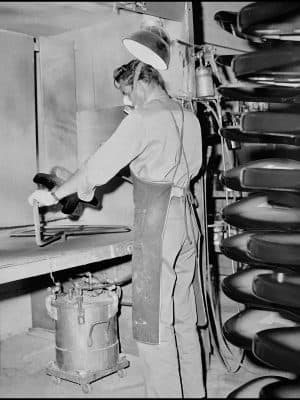
Gibson's answer
Compared to Bigby’s top-mounted unit that served as a stationary bridge, Fender’s contributions were more elegant, minimized friction, stayed in tune, had better intonation and could produce much wider pitch bends. Fender’s sales skyrocketed. Shortly thereafter at Gibson, Ted McCarty invented the « tune-o-matic » bridge which, not surprisingly, featured individually adjustable saddles.
The PAF Humbucker
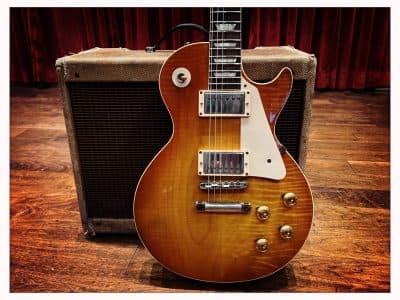
A significant Gibson innovation happened in 1957 that would go on to become an industry standard. Staff engineer Seth Lover perfected a double-coil pickup, designed to cancel out ground hum and other noise issues that had long plagued single coil pickups – like Gibson’s P90, and even those designed and used by Fender as well.
This new « humbucker » pickup design was manufactured and quickly put into Les Paul models starting in 1957 – even before the patent had been approved by the U.S. Patent Office. These early « PAF » (Patent Applied For) pickups would revolutionize guitar tone and become the most revered humbucker pickups in the world for pro players, guitar aficionados and collectors alike.
Out of production?
Unfortunately, just as the Les Paul reached its zenith in refinement and design (tune-o-matic bridges, sunburst finish options, and the PAF humbucker pickups), sales started to slow down dramatically for Gibson’s solid-body line. Between 1958 and 1960, Gibson only produced 1700 Les Paul Standard guitars before dropping the original model entirely. Two other models that were also introduced in 1958 – the Flying V (only 100 sold), and the Explorer (less than 30 sold) were also discontinued in 1959. It seems impossible to believe that the original single cut-away Les Paul model would be out of production until 1968!
Gibson's Resurrection
Between 1963 and 1968, Gibson also suffered a high turnover in trained personnel as the result of labor strikes. Fortunately, there was hope in the least likely of places – the United Kingdom.
American blues artists B.B.King, Howling Wolf, Muddy Waters, and most notably, Freddie King were widely admired and listened to by a younger generation of English players who were paying careful attention to the guitars that were getting such fantastic tones.
By the end of 1965, Eric Clapton was playing a Les Paul Standard through his Marshall combo amp and it was THE sound of the Blues Breakers album by John Mayall and the Bluesbreakers. The Rolling Stones’ Keith Richards also acquired a ’57 Les Paul during the group’s first US tour in June 1964. Jimmy Page was also playing a black Les Paul Custom on his London recording sessions by late that same year. Peter Green, Clapton’s replacement in the Bluesbreakers, also switched to a Les Paul in late 1965 during his time with Fleetwood Mac. By 1966, Jeff Beck had also started playing Les Paul model guitars; he played them extensively on the first Yardbirds record as well his first Jeff Beck Group record Truth (1968) and into Blow By Blow (1974).
In America, Mike Bloomfield (Butterfield Blues Band, Electric Flag) was the first to gain a solid reputation for using Les Paul guitars as early as 1966. Billy Gibbons (ZZ Top) switched to a 1959 Les Paul (known as « Pearly Gates ») and has used it extensively on every recording since.
Gibson soon became aware of this rising trend in popularity and by 1968 the company had negotiated a new contract with Les Paul (5% royalty on ‘standard cost’ for every model) and had fired up the assembly line to once again make Les Paul model guitars. By the end of 1969, Gibson was cranking out 250-300 Les Paul guitars a day.
From California to New York
Throughout the 1960’s, Fender continued to be the dominant electric guitar company and had expanded its influence and reach from a small electronic repair shop in Fullerton, California to a worldwide brand that symbolized quality and innovation. The sheer volume of different models of amplifiers (tweed, brownface, and blackface) and electric guitars Fender had developed by the mid-sixties far surpassed Gibson. By 1964, Fender was selling 80% of all basses of professional quality in the world, and some new models, like the Mustang, were $15 million dollars backordered.
Fender had 17 models in production including the Stratocaster, Telecaster, Jaguar, Jazzmaster, Bass VI, Precision Bass, and Jazz Bass. Virtually any group or artist ranging in any genre, from blues to western swing, rock to country, played Fender guitars. Artists ranged from the Beach Boys to Buddy Guy, Buddy Holly to Bob Dylan, David Gilmore to Mark Knopfler, Hank Marvin to Jimi Hendrix. Some players, like Eric Clapton and Jeff Beck, would eventually move over to playing Fender Stratocasters exclusively. In short, Fender was fast becoming an iconic American brand.
That was firmly cemented in place on Tuesday, January 5, 1965, when Fender Musical Instruments and Fender Sales Inc. were sold in entirety to CBS (Columbia Broadcasting Systems) for $13,200,000, outpacing their $11,200,000 purchase price for 80% of the New York Yankees just two months earlier. Sadly by late 1969, Fender guitars had deteriorated in build quality and reputation under CBS’s management. Wood was no longer carefully chosen or stored. The quality of custom paint and sunburst finishes were noticeably different. Pickups were made to a cheaper specification. Soon it became harder and harder for CBS to have reliable quality control.
Everlasting Influence
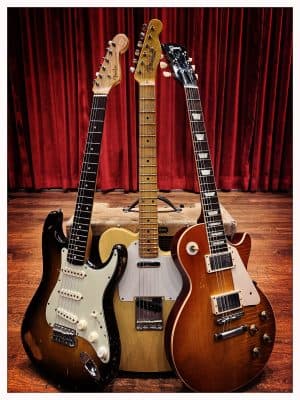
One can easily argue that the most collectable, desirous and sought after production years for both Fender (Stratocasters, Telecaters) and Gibson (Les Paul) is the six year period between 1954 and 1960. This accounts for the ’54 Blackguard (and Whiteguard) Telecaster, the ’57 Strat, and the ’59 Les Paul models. While both companies continue to thrive, reissue, refine, and build on their classic designs, it is the early formative years when these models were introduced that continue to enjoy such high demand and steady increases in value year over year.
Modern boutique luthiers and manufacturers continue to try improve upon these classic designs, from pickups, body and/or neck replacements and hardware. This even carries over into rebuilding and refurbishing the original equipment these classic models were created with (belt sanders, table saws, pickup winding machines, etc.) in order to better understand and refine the process. Whether it’s measuring pickup wire gauges and windings to metallurgy ratios of nickel, cobalt, aluminum and steel, or becoming an expert in wood harvesting techniques and how they differ by type, it seems as if the tradition and nostalgia of the past is here to stay for the foreseeable future.
Perhaps this final example might widen your perspective of just how influential and pervasive these models are. The overwhelming amount of electric guitars in production today by other makers (from boutique to cheap), still use the Telecaster, Stratocaster, or Les Paul for the body design and ergonomic layout. If imitation is the most sincere form of flattery, these guitars are going to be flattered for a very, very long time to come.


